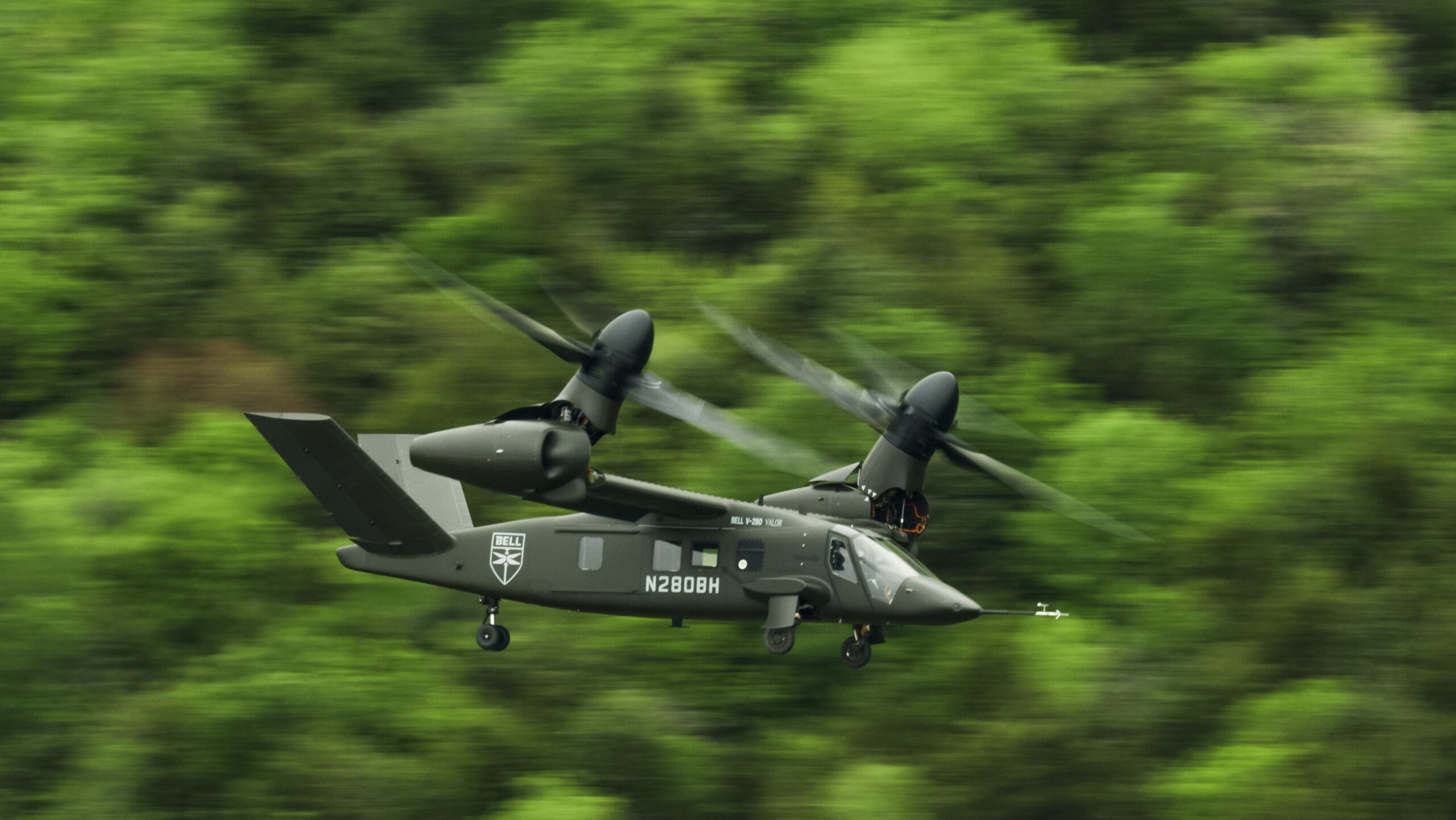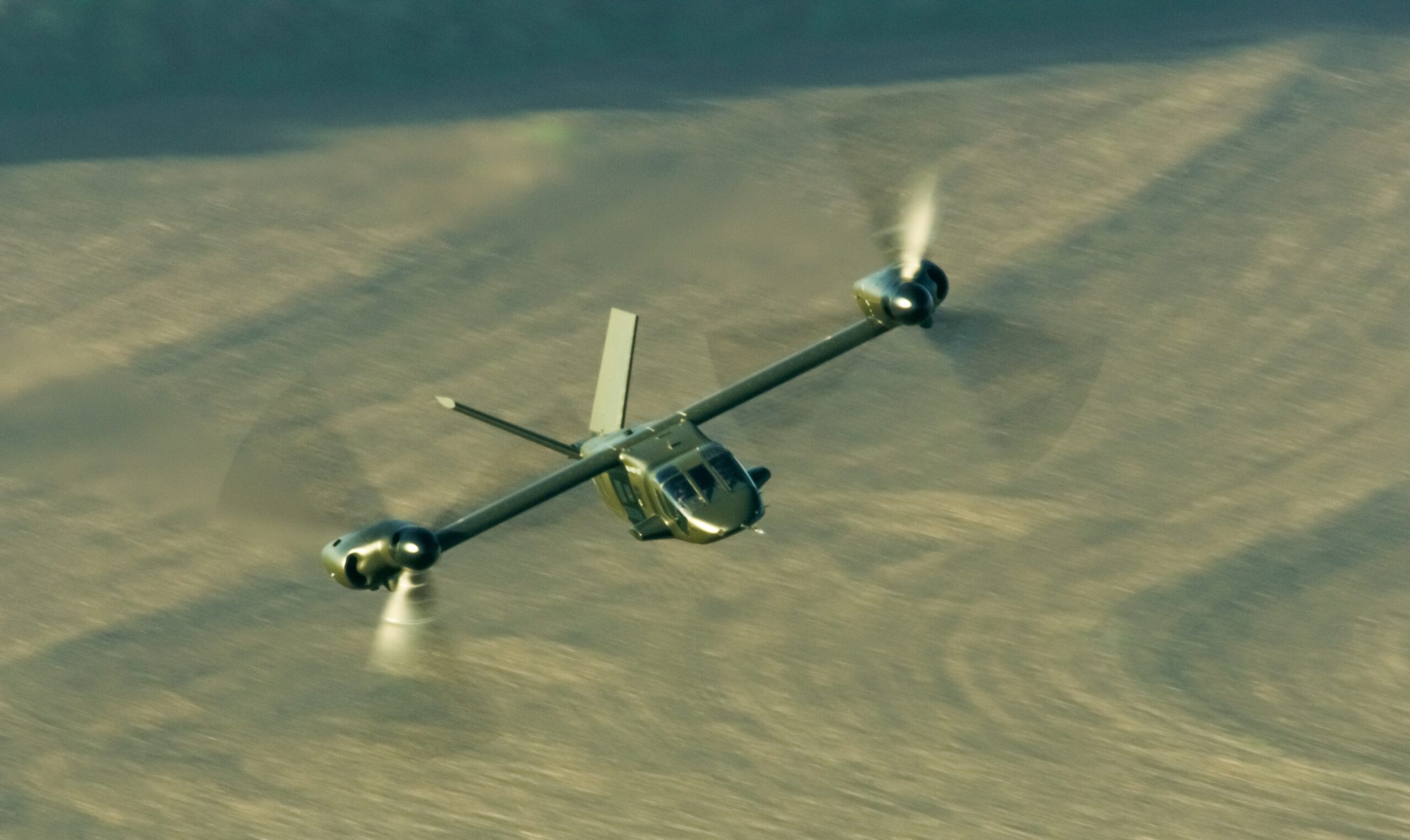
The V-280 tiltrotor’s speed is truly remarkable. By comparison, the demonstrated top speed is almost 60 knots faster than any competing technology. Photo courtesy of Bell.
In any innovative industry, when you have a proven product that provides transformational capability and you leverage all the lessons learned from previous models to continuously improve that capability and the total value proposition, you end up with the best in class.
Combine that with the performance of the team and adherence to commitments made, you’ve made a compelling case that this combination is unmatched. The same can be said for Bell’s V-280 Valor for the Army’s Future Long-Range Assault Aircraft (FLRAA) program for Future Vertical Lift. Bell’s V-280 Valor and the team that designed it have demonstrated performance for every key attribute related to speed, range, and agility, as well as cost, schedule, and performance — with the bonuses being burned-down risk and long-term affordability from a proven tiltrotor platform.
There are facts-based irrefutable points as to the all-around superiority of Bell’s air assault tiltrotor to keep the Army’s aviation speed and range capabilities on par with its other-service partners in the joint all-domain fight.
V-280 Valor paces the threat with superior speed, range, and agility
A tiltrotor is the best FLRAA solution to fulfill the Army’s performance and affordability needs. Low-speed agility, long-range cruise, 305-knot high-speed flight, sling-load performance, fast rope deployment, and mission-systems integration were all proven out over three years and 215 hours of flight testing across an expansive flight regime.
The tiltrotor’s speed is truly remarkable. By comparison, the demonstrated top speed is almost 60 knots faster than any competing technology. That extra speed translates into battlefield mission flexibility, greater range for accessing global challenges, and faster delivery of medical care to increase the survival rate of casualties on the battlefield.
“Every time you hear the Chief or Maj. Gen. Rugen speak, it’s about speed, range, and reach,” said Frank Lazzara, director, Advanced Vertical Lift Systems, Sales and Strategy, who flew CV-22s for Air Force’s Special Operations Command. “It’s about the ability to mass combat force on an objective and close on the enemy as quickly as possible. All these things have been demonstrated by an operational tiltrotor without sacrificing performance at the X.”
While the V-280 presents a slightly wider footprint than the Black Hawk, it also enables the V-280 to be more than 20-percent shorter while, importantly, lacking exposed rotors on the leading and trailing edge of that footprint. This footprint provides landing zone flexibility and improved Soldier safety 360 degrees around the aircraft, which is unique to the V-280 configuration. With routine tilting of the proprotors, actions in and out of the landing zone do not require any clutching or de-clutching mechanisms of complex propulsors.
The key point here is that although once considered more complex than helicopters, tiltrotors are now the least complex way to get to this unmatched performance. Tiltrotor maturity has arrived at the point where it is the known technology with decades of risk reduction earned on a fully operational fleet of aircraft — not a few prototypes with a very modest amount of hours flown over a similar period of time.
When a competitor says somewhat derisively that the V-280 beats them in a drag race, they’re making the argument for Bell — admitting that their prototype is significantly slower than the V-280. Do you think that’s what Soldiers flying into harm’s way want to hear? Speed is always better, and no military commander ever asked for less capability.

Bell has flight-test evidence for the V-280 proving Level 1 attitude quickness in the low-speed regime using its triple redundant fly-by-wire system. Photo courtesy of Bell.
V-280 Valor is agile at both low and high speeds
For aircraft agility, the V-280 busts the myth and misdirection that tiltrotors lack the needed agility. Bell has flight-test evidence proving Level 1 attitude quickness in the low-speed regime using its triple redundant fly-by-wire system. With five separate Army test pilots having flown numerous flights — the Army has first-hand information as to what the V-280 can handle in known and unknown mission challenges.
When flying a tiltrotor on the wing you can maneuver quite aggressively at high speed compared to a rotary wing platform. The V-280 can responsively turn on its side like an airplane and displace from the threat very quickly while still retaining a positive energy state and without stressing its dynamic systems. With a tiltrotor, there are no worries about an overhead rotor system, disc separation, or main rotor mast limitations for rapid maneuvering in high-speed flight.
The tiltrotor has already been unequivocally proven as the most efficient design for combining high-speed and low-speed maneuvering while achieving the extended ranges required to stay relevant over extended land and ocean distances.
Bell’s Team Valor gives Soldiers speed and range as proven over two decades of global military operations by the V-22 Osprey, without sacrificing the agility that the Army has in its current rotary wing fleet in the low-speed environment. It’s not an extrapolated model or a guess, it’s all proven out and the advanced tiltrotor design has been refined by every lesson learned through that real-world, outside-of-a-lab experience.
V-280’s hallmark is reliability, years of tiltrotor logistical experience, and reduced risk
The V-280 configuration benefits from all the lessons learned over 650,000 tiltrotor flight hours by the US military. This is the key significant strength that enabled the next-generation, digitally designed V-280 demonstrator to fly well over a year earlier than any other JMR technology demonstrator and consistently achieve a higher flight-test operational tempo and significantly more flight time. It is this kind of demonstrated and predictable performance that speaks for itself when comparing the rhetoric of maturity, reliability, and maintainability between air-vehicle configurations and translates into life-cycle affordability for the operator.
“What Bell did with the V-280 Valor was to evolve the tiltrotor configuration into a fighting machine designed specifically for the Army air assault and utility missions in contested environments and to be maintainable in the field,” said Carl Coffman, vice president, Future Vertical Lift Strategy at Bell. “We proved that this is not going to be a risky configuration for the Army to adopt because there is no component on the V-280 that you can’t pull with organic ground-support equipment in an austere environment today.”
It’s well known that the cost drivers on rotorcraft are the blades and gearboxes. Those are the ones you want to be able to control and manage, and with the V-280 — an aircraft that spends 85 percent of its time flying at high-speed leveraging its fixed-wing — those cost drivers are significantly minimized. For the V-280, gearboxes are roughly the same size, and the total number of blades is less than even today’s Black Hawk.
That’s a great differentiator in terms of maintainability and affordability for FLRAA. With the threat scenario facing our nation, the Army can’t subject itself to the first-generation challenges of a technology that’s never been operational, especially if they would still have to compromise on speed, range, reach, and survivability to do so.
V-280 Valor is the Lowest-Risk, Highest Performance Choice for Modernization
To address the growing threat from near-peer competitors, the Army’s air assault and medevac missions need a revolution in capability. This critical long-range and high-speed mission can no longer accept the drag of edgewise rotor flight to get the revolutionary capability the Army needs to operate in evolving threat environments.
The test results are in and given the complex geopolitical and budget-constrained environment, it makes sense for the Army to capitalize on decades of tiltrotor development and operation and focus on the proven technology with performance margin to be relevant for generations. When making a major aircraft acquisition decision one might be cautious to initialize a program with a technology that barely meets key performance parameters today and will likely not meet or exceed them a decade from now. It is important to have a technological solution capable of upgrading to remain relevant throughout the program’s life cycle.
The V-280 Valor delivers with high predictability the performance attributes necessary for Army aviation to execute its air assault mission, keep pace with its DoD partners’ capability and enable our nation’s warfighters to maintain competitive dominance in the global geo-political environment over decades to come from the team that has proven its capability to deliver.























